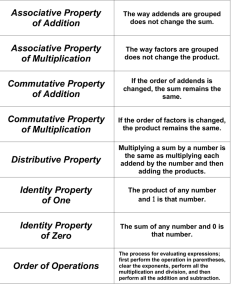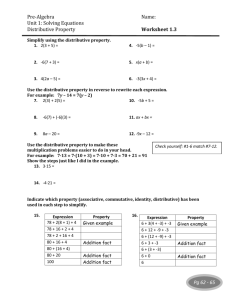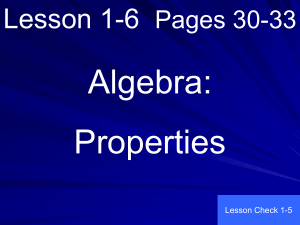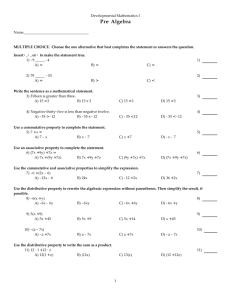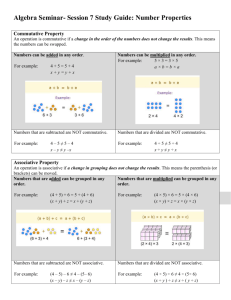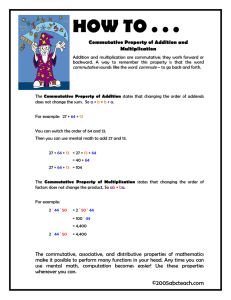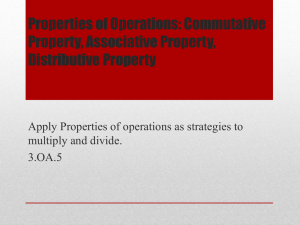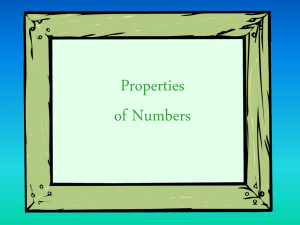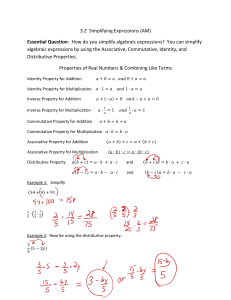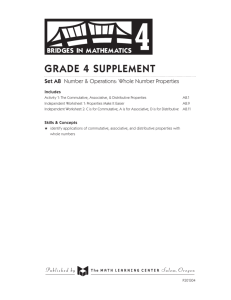Properties: PreAlgebra Understanding the Commutative, Associative
advertisement
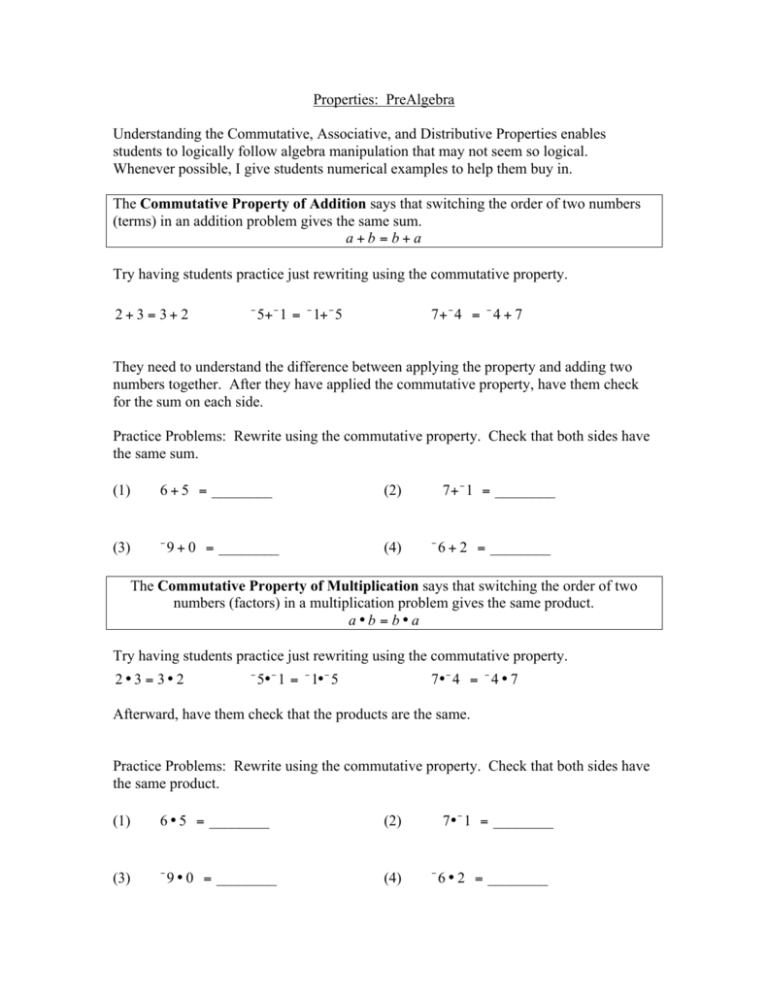
Properties: PreAlgebra Understanding the Commutative, Associative, and Distributive Properties enables students to logically follow algebra manipulation that may not seem so logical. Whenever possible, I give students numerical examples to help them buy in. The Commutative Property of Addition says that switching the order of two numbers (terms) in an addition problem gives the same sum. a+b = b+a Try having students practice just rewriting using the commutative property. 2+3 = 3+ 2 − 7+ − 4 = − 4 + 7 5+ − 1 = − 1+ − 5 They need to understand the difference between applying the property and adding two numbers together. After they have applied the commutative property, have them check for the sum on each side. Practice Problems: Rewrite using the commutative property. Check that both sides have the same sum. (1) 6 + 5 = ________ (3) − 9 + 0 = ________ (2) (4) 7 + − 1 = ________ − 6 + 2 = ________ The Commutative Property of Multiplication says that switching the order of two numbers (factors) in a multiplication problem gives the same product. a•b = b•a Try having students practice just rewriting using the commutative property. 2•3 = 3• 2 − 7•− 4 = − 4 • 7 5•− 1 = − 1•− 5 Afterward, have them check that the products are the same. Practice Problems: Rewrite using the commutative property. Check that both sides have the same product. (1) 6 • 5 = ________ (3) − 9 • 0 = ________ (2) (4) 7•− 1 = ________ − 6 • 2 = ________ The Associative Property of Addition says that when taking the sum of three numbers (terms) that the sum will be the same whether you begin with the first and second number or the second and third. (a + b) + c = a + (b + c) Try having students practice just rewriting using the associative property. (2 + 3) + 1 = 2 + (3 + 1) − 5 + (7 + − 4) =( − 5 + 7)+ − 4 Have the students check that the sums are the same. Practice Problems: Rewrite using the associative property. Check that both sides have the same sum. (1) (5 + 4) + 7 = __________ (2) 3 + (1 + 1) = __________ (3) (8 + 1)+ − 9 = __________ (4) 4 +( − 2 + 2) = __________ The Associative Property of Multiplication says that when taking the product of three numbers(factors) that the product will be the same whether you begin with the first and second number or the second and third. (a • b) • c = a • (b • c) Try having students practice just rewriting using the associative property. (2 • 3) • 1 = 2 • (3 • 1) − 5 • (7 •− 4) =( − 5 • 7)•− 4 Have the students check that the products are the same. Practice Problems: Rewrite using the associative property. Check that both sides have the same product. (1) (5 • 4) • 7 = __________ (2) 3 • (1 • 1) = __________ (3) (8 • 1)•− 9 = __________ (4) 4 •( − 2 • 2) = __________ The Distributive Property says that when a number multiplies with a sum, it must multiply with each member (term) of the sum. a (b + c) = a • b + a • c Try having the students rewrite problems using the distributive property. 2 (3 + 5) = 2 • 3 + 2 • 5 − 4 (1 + 6) = − 4 • 1 + − 4 • 6 Have the students check that the answers would be the same if using “order of operations” or the distributive property. Practice Problems: Rewrite using the distributive property. Check that both sides have the same result. (1) 5 (4 + 7) = __________ (2) 3 (1 + 1) = __________ (3) 8 (1 + − 9) = __________ (4) 4 ( − 2 + 2) = __________ Note: Once my students learn the Distributive Property, they have a hard time remembering that Order of Operations still works, in some cases. Order of Operations is fine for the following. 2 (1+ 3) = 2(4) =8 Order of Operations will not do for the following. 2( x + 3) And the reason? There are not like terms in the parentheses. So, we must go to the Distributive Property. = 2• x + 2•3 = 2x + 6 What is the point of this story? Please help students focus on the fact that the Distributive Property can be used to replace Order of Operations in problems of type a (b + c) , but that it is unnecessary, if b and c are like terms. Apply the distributive property. (1) 3 ( x + 4) =___________ answers: (1) 3 x + 12 (2) − 6a − 8 (2) − 2 (3a + 4) =__________

